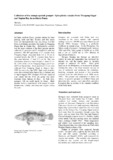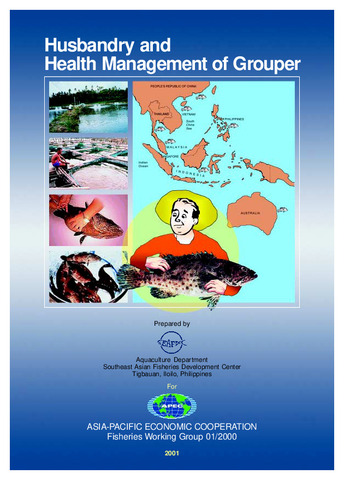Preliminary studies on the rearing of the red-spotted grouper, Epinephelus coioides larvae using copepod nauplii as initial food
| dc.contributor.author | Toledo, Joebert D. | |
| dc.contributor.author | Golez, Salvacion N. | |
| dc.contributor.author | Doi, Masanori | |
| dc.contributor.author | Bravo, Roberto S. | |
| dc.contributor.author | Hara, Shiro | |
| dc.date.accessioned | 2013-04-15T03:56:50Z | |
| dc.date.available | 2013-04-15T03:56:50Z | |
| dc.date.issued | 1996 | |
| dc.identifier.citation | Toledo, J. D., Golez, S. N., Doi, M., Bravo, R. S., & Hara, S. (1996). Preliminary studies on the rearing of the red-spotted grouper, Epinephelus coioides larvae using copepod nauplii as initial food. UPV Journal of Natural Sciences, 1(2), 119–129. | en |
| dc.identifier.issn | 0118-461X | |
| dc.identifier.uri | http://hdl.handle.net/10862/1574 | |
| dc.description.abstract | One day old red-spotted grouper (Epinephelus coioides) larvae from SEAFDEC, Iloilo, were packed at 3.300 ind/L and transported to Dagupan, Pangasinan for larval rearing. Transport time was about 10 hours. More than 90% of the larvae were active after transport. These were reared in two 7-on tanks (Tanks 1 and 2) using Acartia nauplii and rotifers as a initial food and in one 10-ton tank (Tank 3) provided with rotifers only. Feeding incidence at the onset of feeding (Day 3) was higher (90-95%) in Tanks 1 and 2 than in tank 3 (85%). All larvae sampled from days 4 – 10 in Tanks 1 and 2 had food in the gut while feeding incidence in Tank 3 was variable (75-100%). Larvae in Tanks 1 and 2 showed consistently higher food electivity for Acartia nauplii than rotifers. Higher survival rates were observed in Day 13 in tanks provided with copepod nauplii (16-18%) than with the rotifers only (2%). Average total length on Day 13 was higher in copepod-fed larvae (4.5 ± 0.5 mm) than larvae fed with rotifers only (3.0 ± 0.3mm). All larvae fed with rotifers alone died on Day 15. A total of 675 larvae were harvested on Day 45 from Tanks 1 and 2. These results indicate the feasibility of transporting one day old E. coioides larvae for at least 10 h and of using copepod nauplii as food for the first feeding E. coioides larvae. | en |
| dc.language.iso | en | en |
| dc.publisher | University of the Philippines in the Visayas | en |
| dc.subject | Epinephelus coioides | en |
| dc.title | Preliminary studies on the rearing of the red-spotted grouper, Epinephelus coioides larvae using copepod nauplii as initial food | en |
| dc.type | Article | en |
| dc.citation.volume | 1 | |
| dc.citation.issue | 2 | |
| dc.citation.spage | 119 | |
| dc.citation.epage | 129 | |
| dc.citation.journalTitle | UPV Journal of Natural Sciences | en |
| seafdecaqd.library.callnumber | VF SJ 0527 | |
| seafdecaqd.databank.controlnumber | 1996-23 | |
| dc.subject.asfa | diet | en |
| dc.subject.asfa | fish culture | en |
| dc.subject.asfa | fish larvae | en |
| dc.subject.asfa | cultured organisms | en |
| dc.subject.asfa | nutritive value | en |
| dc.subject.asfa | rearing techniques | en |
| dc.subject.scientificName | Epinephelus coioides | en |
Files in this item
| Files | ขนาด | รูป | View |
|---|---|---|---|
|
There are no files associated with this item. |
|||
รายการนี้ปรากฏใน (s)
-
Journal Articles [1258]
These papers were contributed by Department staff to various national and international journals.



